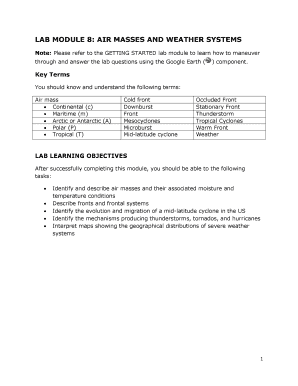Loading

Get Lab Module 8: Air Masses And Weather Systems
How it works
-
Open form follow the instructions
-
Easily sign the form with your finger
-
Send filled & signed form or save
How to fill out the LAB MODULE 8: AIR MASSES AND WEATHER SYSTEMS online
This guide provides clear instructions for completing the LAB MODULE 8: AIR MASSES AND WEATHER SYSTEMS form online. Follow these steps to successfully navigate the components of the module and enhance your understanding of air masses and weather systems.
Follow the steps to complete your LAB MODULE 8 effectively.
- Click the ‘Get Form’ button to obtain the form and open it in the editor.
- Expand the INTRODUCTION folder and select Topic 1: Weather. Read the material carefully, then answer Question 1 by briefly describing the likely weather conditions evident in the provided picture.
- Proceed to Topic 2: Air Masses. Answer Question 2 regarding the absence of mA and cE classifications by explaining the primary reason.
- Continue to Topic 3: The Evolution and Weather Conditions of Fronts. Compare the density and speed of cold air from the cold front to warm air from the warm front in your answer to Question 3.
- Move to Topic 4: Human Interaction: Tornado Alley. For Question 4, explain why the region between 30°N to 50°N is conducive to tornado generation.
- Collapse and uncheck the INTRODUCTION folder. Expand the GLOBAL PERSPECTIVE folder and describe spatial patterns of air masses. Select the Air Mass folder and answer the questions for Locations A through D regarding city names, principal air masses, air temperatures, and humidity conditions.
- Expand the FRONTS folder and select the Cold front to study the direction of movement and answer corresponding questions about locations E and F.
- Continue by exploring the Warm front. Answer questions about the expected air temperature and rainfall intensity at Location G.
- Expand the MID-LATITUDE CYCLONES folder and review the migration of mid-latitude cyclones. Answer questions regarding air circulation, mass origins, and rainfall durations during each stage of the cyclone.
- Expand the THUNDERSTORMS AND TORNADOS folder to understand the formation and classification of thunderstorms and tornadoes. Use the information to answer questions about the stages of development.
- Finally, explore the TROPICAL CYCLONES section, study the historical tracks, and respond to questions related to hurricanes and their impacts.
- Once all sections are completed, ensure to save your changes, download, print, or share the form as necessary.
Complete your LAB MODULE 8 documents online today to improve your knowledge of air masses and weather systems!
They are classified as continental or maritime - dependent on whether they originate over land or sea - and arctic or antarctic, equatorial, tropical, or polar, depending on the particular region in which they form.
Industry-leading security and compliance
US Legal Forms protects your data by complying with industry-specific security standards.
-
In businnes since 199725+ years providing professional legal documents.
-
Accredited businessGuarantees that a business meets BBB accreditation standards in the US and Canada.
-
Secured by BraintreeValidated Level 1 PCI DSS compliant payment gateway that accepts most major credit and debit card brands from across the globe.


